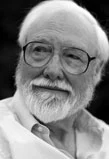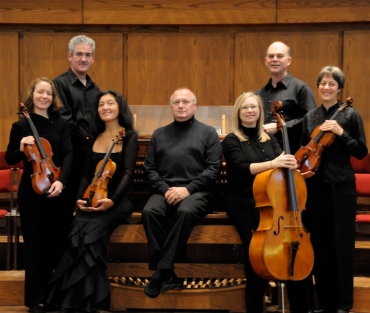The Well-Tempered Ear
Classical music: Con Vivo turns in a polished performance of mixed and unusual repertoire, and allows a comparison of acoustics and seating distance to be made
5 Comments
By Jacob Stockinger
Here is a special posting, a review written by frequent guest critic and writer for this blog, John W. Barker. Barker (below) is an emeritus professor of Medieval history at the University of Wisconsin-Madison. He also is a well-known classical music critic who writes for Isthmus and the American Record Guide, and who for 12 years hosted an early music show every other Sunday morning on WORT FM 89.9 FM. He serves on the Board of Advisors for the Madison Early Music Festival and frequently gives pre-concert lectures in Madison. He also took the performance photos, some at the First Congregational United Church of Christ and some at the Capitol Lakes Retirement Center.
By John W. Barker
Last Friday night, the chamber music ensemble Con Vivo (Music With Life) gave its winter concert at the First Congregational United Church of Christ.
It was a large program of nine relatively short pieces, designed to allow eight members of the group to show off their skills in solos, in duets and in trio pairings.
Participants were: Robert Taylor, clarinet; Cynthia Cameron-Fix, bassoon; Olga Pomolova and Kathryn Taylor, violins; Janse Vincent, viola; Derek Handley, cello; Dan Lyons, piano; and Don DeBruin, organ.
The opening and closing items—Mikhail Glinka’s Trio pathétique and Felix Mendelssohn’s Konzertstück No. 2, combined clarinet and bassoon with piano (below).
A corresponding combination of clarinet, viola and piano (below) was mustered for two of Max Bruch’s Eight Pieces, Op. 83.
In string groupings, two violins (below) played one of Georg Philipp Telemann’s Canonic Sonatas (you can hear an example in a YouTube video at the bottom), and, with piano added, Three Duets by Dmitri Shostakovich.
Violin and viola rendered the Little Suite for Autumn by Peter Schickele (the real person behind “P.D.Q. Bach”).
Franz Danzi’s Duet, Op. 9., No. 1, called for viola and cello (below), while George Crumb’s Sonata was for solo cello.
And, for good measure, there was a duet by Clifford Demarest for piano and organ.
The program was certainly varied. It ranged from deeply diluted pseudo-Copland (Schickele) and unabashedly entertaining trivia (Shostakovich) through Telemann’s contrapuntal wit and Danzi’s artful string contrasts (though too deeply caught up in the viola’s upper register), to the varied colors of winds and piano.
Surely the most striking piece was Crumb’s sonata, a tough work that is not easy listening but provocatively interesting, and was dazzlingly played by Handley.
Rather a throwaway, though, was the Demarest duet, in which the powerful organ sound all but totally overwhelmed the piano.
As it happened, this group gave the same program (less the Demarest) at the Grand Hall of the Capitol Lakes Retirement Center the evening before.
I found it a good opportunity to compare the contributions of differing acoustics to chamber music listening. For such experience, I like to sit very close to the players, and I could do this at the Thursday performance, and in a modestly sized hall with fine acoustics for music.
But the First Congregational Church is a long, deep hall, and I sat about halfway back in it. Its reverberations can add a nice bloom to projected sound, but also some blur.
This was certainly the case where the two wind instruments tended to meld. And when the viola was at the piano, at the back of the chancel, it almost disappeared at times, while other two-string combinations were not always crystal clear.
I have had growing concerns about First Congo as a venue for chamber music, and I should think the Con Vivo folks must think about this. And listeners should, also. Clearly, where you sit for intimate music-making has its effects.
For all that, I enjoyed the group’s program in each setting, and renewed my admiration for their artistry and enterprise.
Tags: Aaron Copland, acoustics, American Record Guide, Arts, Autumn, Baroque, Bassoon, Canon, Cello, Chamber music, clarinet, Classical music, counterpoint, duet, duo, Early music, Franz Danzi, George Crumb, Isthmus, Jacob Stockinger, John W. Barker, Madison, Madison Early Music Festival, Medieval history, Music, organ, PDQ Bach, Peter Schickele, Piano, Shostakovich, Sonata, Telemann, United States, University of Wisconsin-Madison School of Music, University of Wisconsin–Madison, Viola, Violin, winter, wit, WORT-FM 89.9, YouTube
- May 2024
- April 2024
- March 2024
- February 2024
- January 2024
- December 2023
- November 2023
- October 2023
- September 2023
- August 2023
- July 2023
- June 2023
- May 2023
- April 2023
- March 2023
- February 2023
- January 2023
- December 2022
- October 2022
- September 2022
- June 2022
- May 2022
- April 2022
- March 2022
- July 2021
- June 2021
- May 2021
- April 2021
- March 2021
- February 2021
- January 2021
- December 2020
- November 2020
- October 2020
- September 2020
- August 2020
- July 2020
- June 2020
- May 2020
- April 2020
- March 2020
- February 2020
- January 2020
- December 2019
- November 2019
- October 2019
- September 2019
- August 2019
- July 2019
- June 2019
- May 2019
- April 2019
- March 2019
- February 2019
- January 2019
- December 2018
- November 2018
- October 2018
- September 2018
- August 2018
- July 2018
- June 2018
- May 2018
- April 2018
- March 2018
- February 2018
- January 2018
- December 2017
- November 2017
- October 2017
- September 2017
- August 2017
- July 2017
- June 2017
- May 2017
- April 2017
- March 2017
- February 2017
- January 2017
- December 2016
- November 2016
- October 2016
- September 2016
- August 2016
- July 2016
- June 2016
- May 2016
- April 2016
- March 2016
- February 2016
- January 2016
- December 2015
- November 2015
- October 2015
- September 2015
- August 2015
- July 2015
- June 2015
- May 2015
- April 2015
- March 2015
- February 2015
- January 2015
- December 2014
- November 2014
- October 2014
- September 2014
- August 2014
- July 2014
- June 2014
- May 2014
- April 2014
- March 2014
- February 2014
- January 2014
- December 2013
- November 2013
- October 2013
- September 2013
- August 2013
- July 2013
- June 2013
- May 2013
- April 2013
- March 2013
- February 2013
- January 2013
- December 2012
- November 2012
- October 2012
- September 2012
- August 2012
- July 2012
- June 2012
- May 2012
- April 2012
- March 2012
- February 2012
- January 2012
- December 2011
- November 2011
- October 2011
- September 2011
- August 2011
- July 2011
- June 2011
- May 2011
- April 2011
- March 2011
- February 2011
- January 2011
- December 2010
- November 2010
- October 2010
- September 2010
- August 2010
- July 2010
- June 2010
- May 2010
- April 2010
- March 2010
- February 2010
- January 2010
- December 2009
- November 2009
- October 2009
- September 2009
- August 2009
Archives
- 2,491,361 hits
Blog Stats
Recent Comments
| Brian Jefferies on Classical music: A major reass… | |
| welltemperedear on What made Beethoven sick and… | |
| rlhess5d5b7e5dff on What made Beethoven sick and… | |
| welltemperedear on Beethoven’s Ninth turns 200… | |
| Robert Graebner on Beethoven’s Ninth turns 200… |
Tags
#BlogPost #BlogPosting #ChamberMusic #FacebookPost #FacebookPosting #MeadWitterSchoolofMusic #TheEar #UniversityofWisconsin-Madison #YouTubevideo Arts audience Bach Baroque Beethoven blog Cello Chamber music choral music Classical music Compact Disc composer Concert concerto conductor Early music Facebook forward Franz Schubert George Frideric Handel Jacob Stockinger Johannes Brahms Johann Sebastian Bach John DeMain like link Ludwig van Beethoven Madison Madison Opera Madison Symphony Orchestra Mead Witter School of Music Mozart Music New Music New York City NPR opera Orchestra Overture Center performer Pianist Piano post posting program share singer Sonata song soprano String quartet Student symphony tag The Ear United States University of Wisconsin-Madison School of Music University of Wisconsin–Madison Viola Violin vocal music Wisconsin Wisconsin Chamber Orchestra wisconsin public radio Wolfgang Amadeus Mozart YouTube





